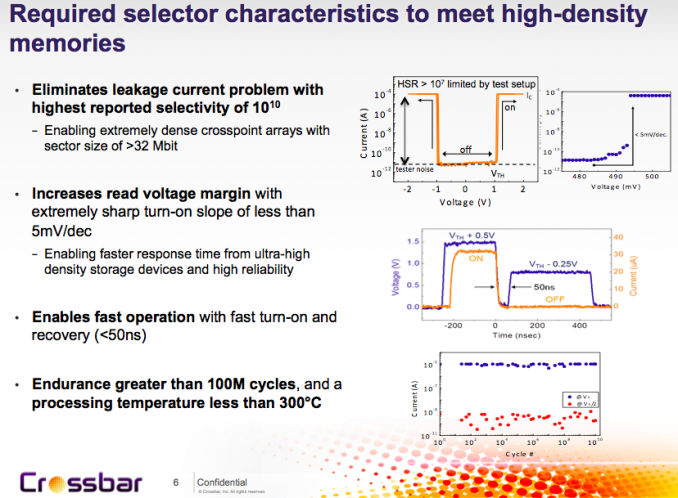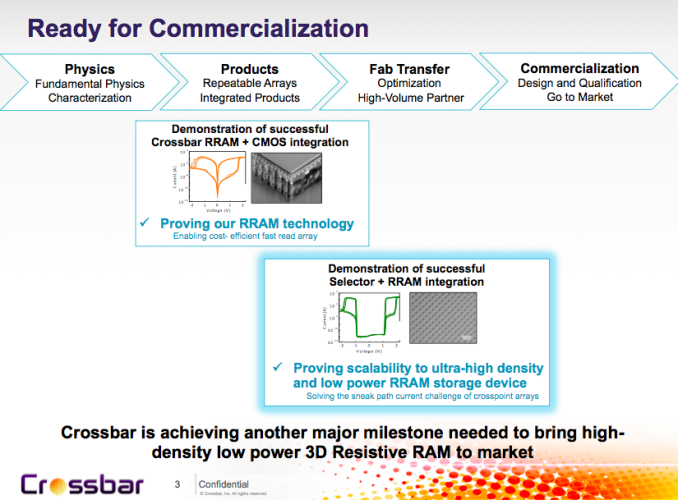Crossbar's Resistive RAM Technology Reaching Commercialisation Stage
by Kristian Vättö on December 21, 2014 4:35 PM EST- Posted in
- Storage
- SSDs
- Resistive RAM
- RRAM
- Crossbar

While the first 3D NAND chips have just found their way to the market and most NAND manufacturers are still developing their designs, there are already a handful of next generation memory technologies in development that are slated to supersede NAND in the next decade or so. One of the most promising technologies is Resistive Random Access Memory, which is more commonly referred to as Resistive RAM or just RRAM. Similar to NAND, RRAM is non-volatile, meaning that it will retain data without power unlike regular DRAM, which needs a continuous power source. Multiple companies are developing RRAM including semiconductor giants like Samsung and SanDisk, but Crossbar, a US based startup, has probably the most advanced design so far.
I've been following Crossbar for quite some time, but I haven't written anything about the company until now. The company was founded in 2010, headquarters in Santa Clara, California and has secured over $50 million in funding. The company's roots come from the University of Michigan and its Chief Scientist and co-founder, Prof. Wei Lu, is currently an associate professor at the university. The Crossbar team consists of 40-45 members at this point, of which most have extensive backgrounds in semiconductor research and development.
The big benefits RRAM have over NAND are performance and endurance. NAND read latencies are typically in the order of hundreds of microseconds, whereas Crossbar claims latency of as low as 50 nanoseconds for its RRAM design. Endurance in turn can be millions of program/erase cycles, although for the early designs Crossbar is aiming at more conservative ~100K cycles.
Last week at IEDM Crossbar announced that it is now entering the commercialization stage. In other words, it has already shown a working silicon and it has also proved that the design can be transferred to commercial fab for high volume manufacturing, so the company is now working with the fabs to build final products.
At first Crossbar is aiming at the embedded market and is licensing its technology to ASIC, FPGA and SoC developers with first samples arriving in early 2015, and mass production scheduled for late 2015 or early 2016. Aside from licensing, Crossbar is also developing standalone chips with higher capacity and density, which should enter the market about a year after the embedded RRAM designs (i.e.most likely sometime in 2017).
The beauty of RRAM is that it can be manufactured using a regular CMOS process with only a few modifications. NAND and especially 3D NAND require expensive special tools (for things like high aspect ratio etching), which is why only a handful of companies are making 3D NAND. RRAM in turn can be manufactured by practically any existing fab with very little added cost, which ultimately results in lower prices due to more competition.
Additionally, RRAM doesn't share NAND's lithography issues. As we know, the sole reason why 3D NAND was invented is because planar NAND can't really scale below 15nm without serious endurance and performance considerations. However, RRAM can efficiently scale to 4-5nm without any issues and in fact Crossbar has already demonstrated an 8nm chip that it built in its R&D labs (most likely using multiple patterning). Moreover, RRAM can be stacked vertically to create a 3D crosspoint array for increased density and so far Crossbar is at three layers, but first commercial standalone chips are expected to feature 16 layers and up to 1Tbit capacity.
Obviously, there are still several hurdles to cross before RRAM is ready to challenge NAND, but it's good to hear that there has been significant progress in development and the technology has gained interest from the fab companies. Faster, more durable and cheaper SSDs and other storage devices are a win for everyone and ultimately even 3D NAND is just an interim solution until something better comes around, which may very well be RRAM. I'll be doing a more in-depth article about RRAM technology in the coming months as this article was more of a heads up about the state of RRAM and Crosspoint's recent developments, so stay tuned for a deeper analysis!












65 Comments
View All Comments
WatcherCK - Sunday, December 21, 2014 - link
A super speed solid state drive than can scale up to multi TBs in size and (after some evolutions from the initial production model) effectively will last a human lifetime... big storage may not like selling something the consumer/prosumer/OEM only ever needs to buy one of :)As an aside TechReports SSD torture test has the Samsung 840 Pro at 2PBs of written data and still trucking along ... http://techreport.com/review/27436/the-ssd-enduran...
arnavvdesai - Sunday, December 21, 2014 - link
Really looking forward to the article. Does the name RRAM actually mean that the idea is to replace the RAM in your PC with these (with the added benefit of being it non-volatile)? My assumption was that RAM was the fastest accessible memory for a CPU (outside of any cache it has built in). If that is the case then is the assumption for that general computation devices the OS would be completely loaded on it?tuxRoller - Sunday, December 21, 2014 - link
Can't replace ram due to limited write cycles.Should be quite interesting in the embedded space.
Tchamber - Sunday, December 21, 2014 - link
I understand that this technology is an alternative to NAND storage. Even at 50 micro seconds it will have too much latency for a replacement for conventional RAM. And even at its high durability, I'd guess DDR3/4 have orders of magnitude more read/write durability...iwod - Sunday, December 21, 2014 - link
It is 50 nano seconds, not micro seconds. And DDR Memory operate at around 10ns. At first i was guessing this would be the solution for superfast embedded solution like in a smartphone. Where current NAND at its size pretty much limit the performance. But then 3D NAND should allow current best desktop class SSD performance on a phone, and possibly even better.So what benefits do RRAM brings to the table? Are the latency improvement worth the price?
nirwander - Sunday, December 21, 2014 - link
It's technologically cheaper to produce 3D RRAM than 3D NAND (in perspective) and RRAM is better in every other aspect, so HW companies will invest in it anyway.beginner99 - Monday, December 22, 2014 - link
And price is what matters most. If it was more expensive than NAND it would not be adopted just because it is faster or if only for enterprise segment with according pricing.Gigaplex - Friday, December 26, 2014 - link
So why did we get SSDs in the first place if they cost more than HDDs? Sometimes performance is enough.hpglow - Monday, December 22, 2014 - link
Try reading the article to find the benefits.Kristian Vättö - Monday, December 22, 2014 - link
It's certain that RRAM won't be adopted by the mainstream space until its price is competitive with NAND. However, there are more benefits that just latency and endurance because RRAM doesn't have the same block structure as NAND has. I.e. it doesn't have to be erased in blocks (actually, it doesn't need erasing at all as data can be overwritten), which means that there is practically no need for garbage collection and wear-leveling. That in turn allows for simpler controller designs as less processing power is needed, which is excellent for mobile devices since power is always a big limitation in mobile devices. But I'll cover the basics of RRAM and its pros and cons in more depth soon :)